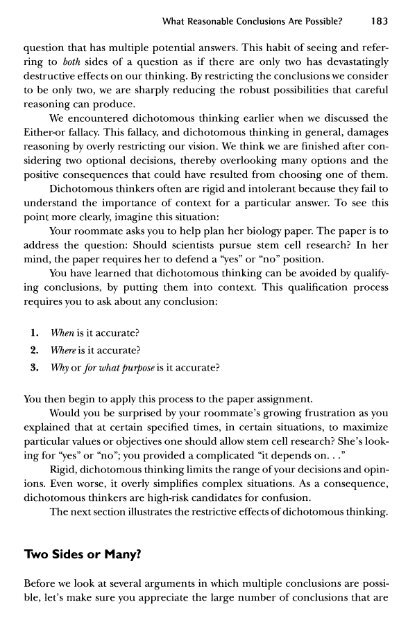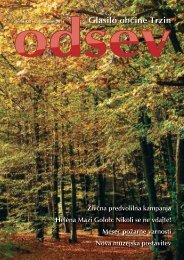Asking the Right Questions, A Guide to Critical Thinking, 8th Ed
Asking the Right Questions, A Guide to Critical Thinking, 8th Ed
Asking the Right Questions, A Guide to Critical Thinking, 8th Ed
Create successful ePaper yourself
Turn your PDF publications into a flip-book with our unique Google optimized e-Paper software.
What Reasonable Conclusions Are Possible? 183<br />
question that has multiple potential answers. This habit of seeing and referring<br />
<strong>to</strong> both sides of a question as if <strong>the</strong>re are only two has devastatingly<br />
destructive effects on our thinking. By restricting <strong>the</strong> conclusions we consider<br />
<strong>to</strong> be only two, we are sharply reducing <strong>the</strong> robust possibilities that careful<br />
reasoning can produce.<br />
We encountered dicho<strong>to</strong>mous thinking earlier when we discussed <strong>the</strong><br />
Ei<strong>the</strong>r-or fallacy. This fallacy, and dicho<strong>to</strong>mous thinking in general, damages<br />
reasoning by overly restricting our vision. We think we are finished after considering<br />
two optional decisions, <strong>the</strong>reby overlooking many options and <strong>the</strong><br />
positive consequences that could have resulted from choosing one of <strong>the</strong>m.<br />
Dicho<strong>to</strong>mous thinkers often are rigid and in<strong>to</strong>lerant because <strong>the</strong>y fail <strong>to</strong><br />
understand <strong>the</strong> importance of context for a particular answer. To see this<br />
point more clearly, imagine this situation:<br />
Your roommate asks you <strong>to</strong> help plan her biology paper. The paper is <strong>to</strong><br />
address <strong>the</strong> question: Should scientists pursue stem cell research? In her<br />
mind, <strong>the</strong> paper requires her <strong>to</strong> defend a "yes" or "no" position.<br />
You have learned that dicho<strong>to</strong>mous thinking can be avoided by qualifying<br />
conclusions, by putting <strong>the</strong>m in<strong>to</strong> context. This qualification process<br />
requires you <strong>to</strong> ask about any conclusion:<br />
1. When is it accurate?<br />
2. Where is it accurate?<br />
3. Why or for what purpose is it accurate?<br />
You <strong>the</strong>n begin <strong>to</strong> apply this process <strong>to</strong> <strong>the</strong> paper assignment.<br />
Would you be surprised by your roommate's growing frustration as you<br />
explained that at certain specified times, in certain situations, <strong>to</strong> maximize<br />
particular values or objectives one should allow stem cell research? She's looking<br />
for "yes" or "no"; you provided a complicated "it depends on. . ."<br />
Rigid, dicho<strong>to</strong>mous thinking limits <strong>the</strong> range of your decisions and opinions.<br />
Even worse, it overly simplifies complex situations. As a consequence,<br />
dicho<strong>to</strong>mous thinkers are high-risk candidates for confusion.<br />
The next section illustrates <strong>the</strong> restrictive effects of dicho<strong>to</strong>mous thinking.<br />
Two Sides or Many?<br />
Before we look at several arguments in which multiple conclusions are possible,<br />
let's make sure you appreciate <strong>the</strong> large number of conclusions that are



